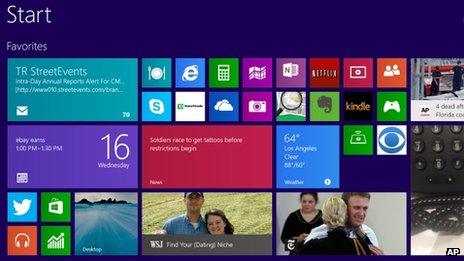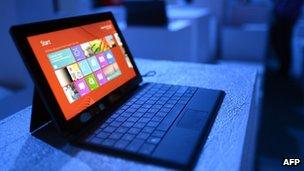Windows 8.1 gets global release
- Published

The update for Windows 8 restores some features to the operating system
Microsoft has released the Windows 8.1 update for its flagship operating system.
The download seeks to address some of the criticisms levelled at the original version of Windows 8.
In particular, the update restores the start button and allows a computer to boot up with a traditional desktop interface.
The launch comes at a critical time for Microsoft as it seeks a new boss, with PC sales experiencing a long decline.
Windows 8 sought to bridge the gap between touchscreen devices, such as tablets and smartphones, and more traditional form laptops and desktop machines. As such it had an interface built of tiles that could be tapped or swiped to open applications.
However, many people found the tiled interface did not work well for some of the things they were used to doing with a computer.
The changes in 8.1 include:
start button - tapping once on this brings up the tiled interface and a long press opens up system controls
desktop mode - lets people avoid the tiled interface entirely
keyboard shortcuts - removes the need to toggle between different on-screen keyboards when typing numbers and letters
gesture control - some applications, such as those for cooking, can now be paged through without touching a screen
tile sizing - the blocks on the touchscreen interface can be in one of four sizes
web browsing - Windows 8 machines will now display separate web pages side by side
A host of other changes, including better support for multi-tasking and improved links to Microsoft's Xbox game console, are also in the update.
Shrinking sales

Microsoft's touchscreen Surface tablet has not been a hit with consumers
Windows 8 was created to capitalise on the growing popularity of tablets and other portable gadgets. Microsoft needs to get people using its software on these machines because sales of desktop machines are in sharp decline.
Global shipments of PCs hit a five-year low in early October, according to figures from market research firm Gartner. Sales of PCs had now fallen for six quarters in a row, it added. The downward trend in sales statistics were confirmed by IDC, which added that the decline would probably continue into 2014.
The shrinking sales are important for Microsoft because traditionally the bulk of its revenue comes from people and companies buying laptops and desktops and office software to run on them.
It is not clear that Microsoft is adjusting to the changes in the types of gadgets that people use. In July, Microsoft wrote off $900m (£559m) following poor sales of its own-brand Surface touchscreen devices.
At the same time, Microsoft has undergone a major reorganisation and has bought phone maker Nokia. It is also launching a new version of its Xbox games console and has begun searching for a new chief executive.
Servers ready to dispense the update were turned on at 07:00 New York time (12:00 BST). The update is free to those already running Windows 8. Charges will apply if users upgrade to 8.1 from Windows 7. The update comes just over a year after the launch of Windows 8.
- Published10 October 2013
- Published26 September 2013
- Published27 September 2013
- Published26 June 2013